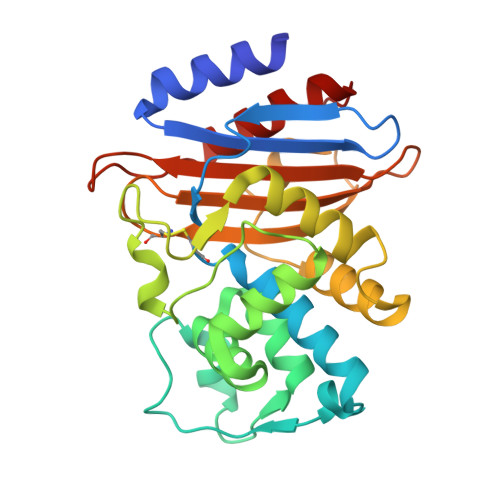Biochemical and Structural Characterization of CRH-1, a Carbapenemase from Chromobacterium haemolyticum Related to KPC beta-Lactamases.
Brunetti, F., Ghiglione, B., Gudeta, D.D., Gutkind, G., Guardabassi, L., Klinke, S., Power, P.(2023) Antimicrob Agents Chemother 67: e0006123-e0006123
- PubMed: 37272821
- DOI: https://doi.org/10.1128/aac.00061-23
- Primary Citation of Related Structures:
8EHU, 8EK9 - PubMed Abstract:
KPC-2 is one of the most relevant serine-carbapenemases among the carbapenem-resistant Enterobacterales. We previously isolated from the environmental species Chromobacterium haemolyticum a class A CRH-1 β-lactamase displaying 69% amino acid sequence identity with KPC-2. The objective of this study was to analyze the kinetic behavior and crystallographic structure of this β-lactamase. Our results showed that CRH-1 can hydrolyze penicillins, cephalosporins (except ceftazidime), and carbapenems with similar efficacy compared to KPC-2. Inhibition kinetics showed that CRH-1 is not well inhibited by clavulanic acid, in contrast to efficient inhibition by avibactam (AVI). The high-resolution crystal of the apoenzyme showed that CRH-1 has a similar folding compared to other class A β-lactamases. The CRH-1/AVI complex showed that AVI adopts a chair conformation, stabilized by hydrogen bonds to Ser70, Ser237, Asn132, and Thr235. Our findings highlight the biochemical and structural similarities of CRH-1 and KPC-2 and the potential clinical impact of this carbapenemase in the event of recruitment by pathogenic bacterial species.
Organizational Affiliation:
Universidad de Buenos Aires, Facultad de Farmacia y Bioquímica, Instituto de Investigaciones en Bacteriología y Virología Molecular (IBaViM), Buenos Aires, Argentina.















